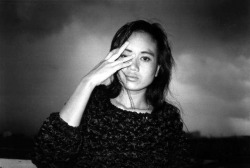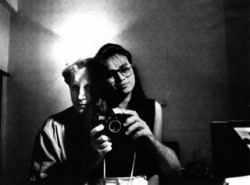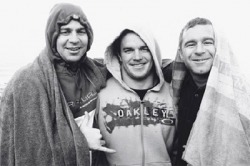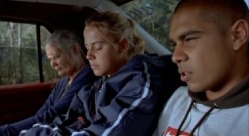Australian Cinema Presentation- Documentary Ethics
Features and Concepts of Dennis O’Rourke’s The Good Woman Of Bangkok (1991) utilising the first reading, “The Ethics Of Documentary Intervention” By Linda Williams
\ The ethics of Intervention: The question of when a journalist or documentarian should cease to occupy the position of objective observer to intervene in the lives of his or her subjects.
\ The representation of reality - “The shift from a more conventional expository and observational mode of documentary to a “witness-centred voice of testimony” leads away from arguments about the world to arguments about the ethics of the filmmaker’s interactions with witnesses: what do they reveal about the filmmaker and what do they disclose about his/her subject?
6 types of gazes
1) The clinical or professional gaze - objective reportage, refraining from any kind of intervention in the situation
\ Example: the interviews with Aoi’s Aunt in the rural town, which O’Rourke does not portray romantically, just as an alternative the lifestyle of Bangkok
2) The accidental gaze – such as the Zapruder footage of the JFK assassination and the Rodney King video by George Holiday, where the event is captured unintentionally
\ Example: -
\ QUESTION: Do you think the accidental gaze has a place within documentary film? If so, can you think of any examples?
3) The helpless gaze - intervention is desirable but impossible, passivity to accept powerlessness
\ Example: O’Rourke’s participation in Aoi’s life, but powerlessness to stop her seeing other clients, and in the end, powerlessness to change her way of life at all
4) The endangered gaze - showing the documentarian’s/camera person’s own risk at being part of the situation, such as in The Battle Of Chile where the cameraman is shot dead whilst still filming
\ Example: O’Rourke’s submersion into the lifestyle of Bangkok, which is in itself dangerous, but also metaphorically exposing himself to the critique of participating in the prostitution industry
5) The humane gaze - when the film conveys a comprehensive subjective response to the moment or the process of death
\ Example: Metaphorical death of Aoi’s former lifestyle, where her previous life breaks down (divorce, single mother, death of her father, loss of rural simplistic life)
6) The interventional gaze - when a filmmaker abandons the distance between themselves and their subject, placing the filmmaker on the same plane of historical contingency as its subjects
\ Example: O’Rourke filming/interviewing the ‘drunken johns’ whilst still participating as one of them, showing their opinions, but still acting upon the same decisions, “O’Rourke is received by them not as an objective, clinical observer, but as a fellow reveller”
A Seventh Gaze? The Participatory Gaze
\ Example: O’Rourke functioning on the same level, in the same situation as the drunken men he is filming, thereby not intervening, “this participatory gaze makes no effort to prevent activities which abuse and objectify women – in fact, it encourages them”.
\ Through intervention an audience is allowed to question the authenticity of the documentary and the interactive forms it incorporates. The ethics of irresponsibility, in which intervention is participatory rather than oppositional, is possible, although deplorable. But we must keep in mind that the situation is only available to us, precisely because O’Rourke is participating in it. It is a quality of documentary’s interactive mode to either be activist and oppositional (responsible intervention) or to be complicit in situations and actions that should be opposed rather than recorded (irresponsible participation)
Documentary truth/ Documentary fiction?
TRUTH: “Truth isn’t guaranteed”
\ The medium of documentary - even ‘fictional’ documentaries seek some highly relative, contingent, non- guaranteed form of truth, otherwise they would be simply fictional. O’Rourke himself has stated that “that there is no neutral objective view; it is implicated in truth and in fiction”. This can be where the power balance between the filmmaker and the subject comes into play. And as explored by Williams, in The Good Woman Of Bangkok this can be dealt with in a colonial discourse.
\ Prostitution itself, needs to be initially established as an interaction between two parties, and then can be explored in terms of O’Rourke representing the coloniser, and Aoi, the colonised. The ‘woman’ is the metaphor of the film, where the sexual language concerning postcolonial societies imitates the internal sexual division of labour of a dominating power.
\ “The issue is not simply whether or not to intervene but to intervene without so radically altering the original situation that one is no longer true to it”. Intervention can spoil the truth he is trying to capture, but by not intervening, he is becoming somewhat of a participant in her abuse. Documentary filmmakers have a responsibility to tell the truth of the situation they represent. The perfect example of this is how O’Rourke reveals at the end that he purchased a rice farm for Aoi, but in reality, he had purchased the rice farm prior to the commencement of filming, which makes you question both of their motives. This is not indicated in the film, therefore those who watch it without questioning, or really researching would believe it was so.
\ “O’Rourke’s purchase of the rice farm at the beginning of his relationship with Aoi, then acting out the fiction that it will be proffered at the end, is one solution to what we night call the vulture problem. In effect, it allows him to depict Aoi’s vulnerability to vultures without leaving her entirely their victim. And it allows him to acknowledge his own complicity with vultures without completely being one”.
\ THERE IS NO WHOLE TRUTH BECAUSE THERE IS NO OBJECTIVE PLACE TO STAND AND SEE IT
\ How did O’Rourke’s withholding information about the rice farm change the power balance of the film? In hindsight, does this change the way you viewed it?
\ The ethics of Intervention: The question of when a journalist or documentarian should cease to occupy the position of objective observer to intervene in the lives of his or her subjects.
\ The representation of reality - “The shift from a more conventional expository and observational mode of documentary to a “witness-centred voice of testimony” leads away from arguments about the world to arguments about the ethics of the filmmaker’s interactions with witnesses: what do they reveal about the filmmaker and what do they disclose about his/her subject?
6 types of gazes
1) The clinical or professional gaze - objective reportage, refraining from any kind of intervention in the situation
\ Example: the interviews with Aoi’s Aunt in the rural town, which O’Rourke does not portray romantically, just as an alternative the lifestyle of Bangkok
2) The accidental gaze – such as the Zapruder footage of the JFK assassination and the Rodney King video by George Holiday, where the event is captured unintentionally
\ Example: -
\ QUESTION: Do you think the accidental gaze has a place within documentary film? If so, can you think of any examples?
3) The helpless gaze - intervention is desirable but impossible, passivity to accept powerlessness
\ Example: O’Rourke’s participation in Aoi’s life, but powerlessness to stop her seeing other clients, and in the end, powerlessness to change her way of life at all
4) The endangered gaze - showing the documentarian’s/camera person’s own risk at being part of the situation, such as in The Battle Of Chile where the cameraman is shot dead whilst still filming
\ Example: O’Rourke’s submersion into the lifestyle of Bangkok, which is in itself dangerous, but also metaphorically exposing himself to the critique of participating in the prostitution industry
5) The humane gaze - when the film conveys a comprehensive subjective response to the moment or the process of death
\ Example: Metaphorical death of Aoi’s former lifestyle, where her previous life breaks down (divorce, single mother, death of her father, loss of rural simplistic life)
6) The interventional gaze - when a filmmaker abandons the distance between themselves and their subject, placing the filmmaker on the same plane of historical contingency as its subjects
\ Example: O’Rourke filming/interviewing the ‘drunken johns’ whilst still participating as one of them, showing their opinions, but still acting upon the same decisions, “O’Rourke is received by them not as an objective, clinical observer, but as a fellow reveller”
A Seventh Gaze? The Participatory Gaze
\ Example: O’Rourke functioning on the same level, in the same situation as the drunken men he is filming, thereby not intervening, “this participatory gaze makes no effort to prevent activities which abuse and objectify women – in fact, it encourages them”.
\ Through intervention an audience is allowed to question the authenticity of the documentary and the interactive forms it incorporates. The ethics of irresponsibility, in which intervention is participatory rather than oppositional, is possible, although deplorable. But we must keep in mind that the situation is only available to us, precisely because O’Rourke is participating in it. It is a quality of documentary’s interactive mode to either be activist and oppositional (responsible intervention) or to be complicit in situations and actions that should be opposed rather than recorded (irresponsible participation)
Documentary truth/ Documentary fiction?
TRUTH: “Truth isn’t guaranteed”
\ The medium of documentary - even ‘fictional’ documentaries seek some highly relative, contingent, non- guaranteed form of truth, otherwise they would be simply fictional. O’Rourke himself has stated that “that there is no neutral objective view; it is implicated in truth and in fiction”. This can be where the power balance between the filmmaker and the subject comes into play. And as explored by Williams, in The Good Woman Of Bangkok this can be dealt with in a colonial discourse.
\ Prostitution itself, needs to be initially established as an interaction between two parties, and then can be explored in terms of O’Rourke representing the coloniser, and Aoi, the colonised. The ‘woman’ is the metaphor of the film, where the sexual language concerning postcolonial societies imitates the internal sexual division of labour of a dominating power.
\ “The issue is not simply whether or not to intervene but to intervene without so radically altering the original situation that one is no longer true to it”. Intervention can spoil the truth he is trying to capture, but by not intervening, he is becoming somewhat of a participant in her abuse. Documentary filmmakers have a responsibility to tell the truth of the situation they represent. The perfect example of this is how O’Rourke reveals at the end that he purchased a rice farm for Aoi, but in reality, he had purchased the rice farm prior to the commencement of filming, which makes you question both of their motives. This is not indicated in the film, therefore those who watch it without questioning, or really researching would believe it was so.
\ “O’Rourke’s purchase of the rice farm at the beginning of his relationship with Aoi, then acting out the fiction that it will be proffered at the end, is one solution to what we night call the vulture problem. In effect, it allows him to depict Aoi’s vulnerability to vultures without leaving her entirely their victim. And it allows him to acknowledge his own complicity with vultures without completely being one”.
\ THERE IS NO WHOLE TRUTH BECAUSE THERE IS NO OBJECTIVE PLACE TO STAND AND SEE IT
\ How did O’Rourke’s withholding information about the rice farm change the power balance of the film? In hindsight, does this change the way you viewed it?





 RSS Feed
RSS Feed